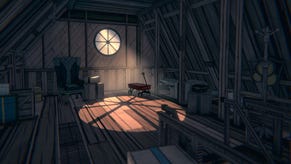Ultra Street Fighter IV's Long Road To Becoming The World's Greatest Fighting Game
Why Street Fighter Belongs To PC
A month or so ago there was a Capcom weekend on Steam, where some of the publisher's finest cuts were free to play for a few days. Out of curiosity as to whether my old 360 arcade stick would work with it I downloaded Ultra Street Fighter IV [official site]. I have a long history with Street Fighter IV and thought I knew what to expect – but the World Warriors blew me away again, and that once-dusty stick is now part of the furniture. Here's why.
The biggest reason I was surprised is because, in my head, Street Fighter IV has been a known quantity for years. It's old. Way back in the day I wrote one of the first cover stories on it, when only Ryu and Ken were playable and director Yoshinoro Ono's talk was all of following the sacred Street Fighter II. An unkind soul might observe that Ono was referring to the business model, and the real target was of course numbers.
Street Fighter II had been a worldwide arcade and home console smash, one of the most famous games in history. Street Fighter III was an extraordinary follow-up, to many people's minds the greatest 2D beat-em-up ever, but it had nowhere near the popular appeal of its predecessor. Capcom toe-dipped with 3D visuals in the mediocre Street Fighter EX, but the early 2000s basically saw Street Fighter wither away – never quite able to recapture that moment in the sun.
Street Fighter IV seemed like a quixotic endeavour when first announced in late 2007. It's easy to look back now and think its success was guaranteed, but Street Fighter has no divine right to exist and 2D beat-em-ups were a badly-fading genre. Since Street Fighter II's heyday a small competitive scene survived, but there were no mainstream hits.
Even more fundamental is that Street Fighter IV is a 2D game design. Knowing that the game would nevertheless have to compete at the top end of the market, Capcom's developers came up with a brilliant fudge – the characters and stages are 3D models, but the game is shown with a fixed side-on camera angle. During certain thumping special moves or ultra attacks, however, the camera moves dynamically to give the best possible shots of the pummelling.
The unkind might call this technique a shallow trick but, and this is the key to much of Capcom's design process, it works. Street Fighter IV's attack animations, for example, have many more frames dedicated to throwing the blow than to the limb's withdrawal afterwards – so after striking an opponent, character arms and legs move back to their normal position far too quickly. But had you ever even noticed? It looks perfect as-is. The 'withdrawal' animations even exist: they were made and removed, rather than never included.
Perhaps the most amazing thing is that this is all in the service of resurrecting an old game and being faithful to its design. I can't think of any comparable project on such a scale. And SFIV's designers had the guts to follow their principles to the most minute level. Consider the 3D models themselves, mostly humanoid in proportion but exaggerating every feature beyond hyper-real – and then accentuating powerful movement with careless-looking ink splashes. They're at once the style's punctuating flourish, and a celebration of the artifice that lifts it beyond 'realistic' 3D styles.
But as soon as something like that begins to intrude on sacred ground, SFIV pulls back. The hitboxes were originally 3D too but, after early feedback indicated testers felt something was off, were soon reverted to the more familiar precision of 2D. Beyond everything else, though, is the drive to make a game anyone can play.
This is not as self-evident a goal as it may seem, because Street Fighter III's whole philosophy was to fix any 'problems' in II and create the pinnacle of complex 2D fight design. It succeeded, but at the cost of jettisoning more casual players who just wanted a knockabout with mates. By the time of Street Fighter III: Third Strike the design had been iterated as close to perfect as it would get, and is still played competitively for that reason, but the fighting club had become a closed shop.
Hitting a balance between mass appeal a la Street Fighter II and retaining the long-term depth for competitive play was Street Fighter IV's toughest test. Opinions may differ but I think SFIV nails it, and one part of both games shows how Capcom's designers solved the SFIII problem of over-specialisation.
The fulcrum of SFIII's fighting system is the parry – when an attack is going to hit your character, there's a six-frame window for you to press towards it and parry the move, taking no damage and leaving your opponent in their recovery frames. The idea is beautiful of course, a moment of calm to cut through the storm, and SFIII's most famous moment (Daigo parrying Justin Wong at EVO) is an ode to the parry's grace and precision. The problem is that most players just don't have the reflexes or predictive knowledge to pull it off reliably, so it's never used. SFIII's absolutely core idea is useless to all but the best.
Street Fighter IV replaces the parry with the focus attack. By holding two buttons a character begins charging and can absorb a single attack – unleashing the buttons at any point to strike and counter, or reaching max charge after a few seconds for an unblockable attack that crumples. There is enormous depth to the focus attack's specifics – it goes through three stages of charge, can be dash-cancelled, can use your super bar to cancel out of special moves, and so on – but the single most important characteristic is that it has a lot of leeway.
The focus attack's time to charge lets slower players set up for an attack, and let go of a fantastic-feeling counter-attack if their opponent weighs in. It lets average players introduce fast, reliable counter-attacks into a game of footsies, and find openings where there might have been stalemates. For experts it simply has tremendous utility, both as an instantaneous set-up against predictable opponents and a last-ditch escape when a whiffed move could mean the end of a round. Street Fighter IV's focus attack is a core part of the fighting system, used by every character, and any player can execute and get some sort of benefit from it.
This much many of us knew years ago. What caught me off-guard about Ultra Street Fighter IV is how much effort Capcom has put into keeping it current – and finally giving the PC the Street Fighter it deserves. It was Street Fighter II that began Capcom's excesses in terms of 'Turbo', 'Super,' 'Hyper' editions and so on.
It's easy to see this as a cynical business model because, let's be honest, it is. But it also happens to suit this kind of videogame perfectly. My love of Street Fighter IV meant I stayed glued at the time Super Street Fighter IV was coming out a year or so later, and that was where myself and chums had left it.
The original SFIV's roster was basically all of the characters from SFII plus four flagship new characters, and a couple of hidden extras. Super added ten more, including of course the four 'new arrivals' from Super Street Fighter II (Dee Jay, T. Hawk etc), and shortly afterwards an Arcade Edition added four more still. I missed the latter and by the time of Ultra (which added five more of its own) the roster had swelled to 44 characters.
That's the first thing that hit me with Ultra: the vast character select screen. A fighting game is all about the characters and their styles, and over seven years Street Fighter IV's roster had risen from 19 to 44. It's not that this process happened overnight, but from my perspective as a player it may as well have. Returning to a game you thought you were done with, and finding it's a genuinely a new proposition is not a common experience.
As I got sucked back in, what I'd expected to be Capcom's usual bare-bones PC job turned out to be possibly the most cutomisable and fully-featured the company has yet produced. Ultra Street Fighter IV PC is a labour of love. It looks incredible by default but there's an enormous amount of graphical options, and yet the system requirements are so low that at max my old rig is still doing 250 frames a second. It can automatically upload favourite replays to youtube, let you watch those of others in-game, and then there's a bonanza of mod skins that let you play as everyone from the Incredible Hulk to a frankly incredible Solid Snake (whose outfit and look switches between different eras of MGS when you change skins.)
My idle hour revisiting an old favourite became a whole weekend of re-mastering the basics and plotting a new tilt at world domination. Come Monday, with the bonanza of training modes tantalisingly incomplete and some scores to settle online, it was an instant addition to my library. And online is the best thing about USFIV – there are four modes plus an online practice mode and, though I only really use 'ranked match,' there are always people to play against. This matters because I've been there for other great games like BlazBlue and even the original SFIV, noticing how it's occasionally taking longer to get a game, until the day comes when it's just searching and searching.
That will one day happen to Ultra Street Fighter IV. But not soon. Because there really isn't anything like it – an audacious bid to revive a past champion that, you might say against the odds, went to the top. The initial design was brilliant but, thanks to re-awakening a long-dormant audience appetite, that became a foundation for more characters, more modes, more costumes and stages and icons, more additions and more editions. What began as in some sense an homage soon became its own work-in-progress.
Words like 'definitive' are thrown around willy-nilly but there's no doubt that Ultra Street Fighter IV is where this grand project ends – with Street Fighter V due next year, this is the final encore. Which makes you look at what Ultra Street Fighter IV represents. It's the product of years of work from Capcom's finest minds, the definitive version of the best fighting game ever made, and one of the best games in recent times full stop. It's a design and an art style that won't fade or be bettered for a very long time. It's a game anyone can have fun playing with and a system that's worth mastering. And more than anything else, USFIV makes the old feel blazingly new again.














